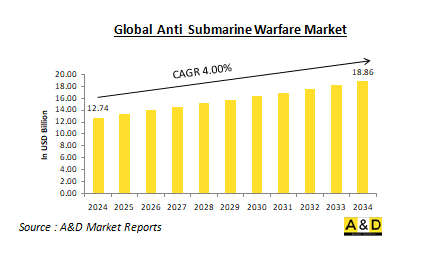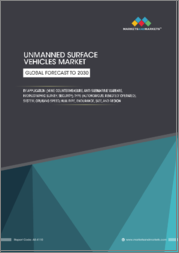
|
시장보고서
상품코드
1552529
세계의 대잠수함전 시장(2024-2034년)Global Anti Submarine Warfare Market 2024-2034 |
||||||
세계 대잠수함전 시장은 2024년 127억 4,000만 달러로 추정되며, 예측 기간(2024-2034년) 동안 4.00%의 연평균 성장률(CAGR)로 확대되어 2034년까지 188억 6,000만 달러로 성장할 것으로 예상됩니다.

세계 대잠수함전 시장 개요
ASW는 잠수함 탐지, 추적, 파괴를 목적으로 하는 전문적인 군사 작전입니다. ASW의 주요 목적은 잠수함 위협을 무력화시키는 것이며, 잠수함은 해군의 작전 및 전략적 이익에 심각한 도전을 초래할 수 있습니다. 잠재력을 부각시켰던 제1차 세계대전으로 거슬러 올라갑니다. 이후 ASW의 전술과 기술은 잠수함 전쟁의 변화하는 성격에 맞추어 빠르게 발전해 왔습니다.
세계 대잠수함전 시장에서 기술의 영향력
기술의 발전은 대잠수함전(ASW) 분야를 획기적으로 변화시켰고, 각국은 탐지, 추적, 교전 능력을 크게 향상시킬 수 있게 되었습니다. 주요 기술 원동력 중 하나는 음파를 이용해 수중 물체를 탐지하고 위치를 파악하는 소나입니다. 최신 소나 시스템은 크게 개선되어 탐지 거리를 늘리고, 정확도를 높이며, 표적을 더 잘 식별할 수 있게 되었습니다. 첨단 센서가 장착된 무인항공기(UAV)는 현재 잠수함의 활동에 대한 중요한 정보를 제공하고, 수면 항적과 음향 방사선을 탐지하고 있습니다. 또한, 넓은 해역에서 잠수함 수색을 위한 무인잠수정(AUV)이 개발되어 이러한 임무에 수상함정이나 잠수함의 필요성을 줄여주고 있습니다. 소나 부표와 수중 음파탐지기를 장착한 대잠 헬리콥터도 잠수함을 탐지하고 추적하는 데 효과적인 도구가 되고 있습니다. 어뢰 기술도 발전하고 있으며, 최신 어뢰는 첨단 호밍 시스템과 확장된 사거리를 특징으로 하여 ASW 작전에서 더욱 효과적일 수 있게 되었습니다.
세계 대잠수함전 시장의 주요 촉진요인
여러 가지 요인이 대잠수함전(ASW) 능력의 발전과 진화를 촉진하고 있습니다. 국가 간 지정학적 긴장은 잠재적 침략을 억제하고 전략적 이익을 보호하기 위한 효과적인 ASW 시스템의 필요성을 증가시키고 있습니다. 또한, 핵무기 확산은 각국이 핵잠수함을 전략무기로 사용하는 것을 막기 위해 노력하면서 ASW의 중요성을 증폭시키고 있습니다. 또한, 해상 무역과 경제적 이익이 큰 국가들은 항로를 보호하고 물자의 흐름이 중단되지 않도록 하기 위해 ASW에 의존하고 있습니다. 기술의 발전은 ASW의 혁신을 더욱 가속화하여 수중전투의 효율성을 높이는 새로운 능력과 전술을 지속적으로 창출하고 있습니다.
세계 대잠수함전 시장의 지역별 동향
대잠수함전(ASW) 작전은 지역마다 다르며, 지리적 요인, 지정학적 역학, 특정 국가 안보 위협에 의해 형성됩니다. 인도 태평양 지역에서는 강대국 간 긴장이 고조되면서 ASW 활동이 급증하고 있습니다. 미국, 중국, 인도, 호주 등 국가들은 잠재적인 해양 위협에 대응하기 위해 ASW 역량에 많은 투자를 하고 있습니다. 북극권에서는 얼음이 녹으면서 해역 접근이 용이해져 ASW 작전의 중요성이 커지고 있습니다. 러시아, 미국, 캐나다, 노르웨이 등 북극권에 이해관계가 있는 국가들은 북극권 영토를 보호하기 위해 ASW 역량을 개발하고 있습니다. 한편, 대서양 지역은 여전히 중요한 전략적 수로이며, 미국과 NATO 국가들은 러시아 및 기타 적대국의 잠재적 위협에 대응하기 위해 ASW에 계속 집중하고 있습니다. 결론적으로, 세계 ASW는 기술 발전과 지정학적 변화, 경제적 이익으로 인해 복잡한 영역으로 발전해 왔습니다. 수중 환경의 경쟁이 치열해짐에 따라 각국은 해상에서의 우위를 유지하고 자국의 전략적 이익을 보호하기 위해 ASW 역량에 대한 투자를 늘리고 있으며, ASW의 미래는 더 많은 기술 혁신과 시시각각 변화하는 지정학적 상황에 의해 형성될 가능성이 높습니다.
대잠수함전 주요 프로그램
General Dynamics는 미 해군에 대잠수함 기뢰를 공급합니다. 미 해군은 해머헤드형 이펙터 시스템을 제조하기 위해 General Dynamics Mission Systems에 2,070만 달러 규모의 수정 계약을 발주했습니다.
이탈리아 해군이 10번째 FREMM 호위함인 에밀리오 비앙키(Emilio Bianchi)를 진수하고 2024년 마지막 분기에 첫 취역할 예정입니다. 이 함정은 의장 작업을 거쳐 2025년 3분기에 이탈리아 해군에 인도될 예정입니다. 대잠수함전용으로 설계된 개량형 FREMM 호위함은 에밀리오 비앙키(Emilio Bianchi)로 불립니다. 이탈리아 해군이 발주한 10척 중 현재까지 8척의 FREMM과 8척의 FREMM이 OCCAR-EA에 의해 인도됐습니다.
Lockheed Martin과 Navantia Sistemas의 보도에 따르면, 스페인 해군의 신형 F-110Bonifaz급에는 AN/SPY-7(V) 2 고체 S밴드 레이더가 탑재될 예정입니다. 2019년 4월, Navantia는 5척의 제작 계약을 체결했으며, 일등함인 Almirante Bonifaz(F-111)의 인도는 2028년으로 예정되어 있습니다. 2028년 인도를 예정하고 있습니다.
목차
대잠수함전 시장 : 보고서 정의
대잠수함전 시장 분석
- 지역별
- 용도별
- 플랫폼별
대잠수함전 시장 분석(향후 10년간)
대잠수함전 시장 기술
세계의 대잠수함전 시장 예측
대잠수함전 시장 : 지역별 동향과 예측
- 북미
- 시장 성장 촉진요인 및 억제요인, 과제
- PEST 분석
- 시장 예측과 시나리오 분석
- 주요 기업
- 공급업체 Tier 상황
- 기업 벤치마킹
- 유럽
- 중동
- 아시아태평양
- 남미
대잠수함전 시장 : 국가별 분석
- 미국
- 방위 계획
- 최신 동향
- 특허
- 현재의 시장 기술 성숙도
- 시장 예측과 시나리오 분석
- 캐나다
- 이탈리아
- 프랑스
- 독일
- 네덜란드
- 벨기에
- 스페인
- 스웨덴
- 그리스
- 호주
- 남아프리카공화국
- 인도
- 중국
- 러시아
- 한국
- 일본
- 말레이시아
- 싱가포르
- 브라질
대잠수함전 시장 : 시장 기회 매트릭스
대잠수함전 시장 : 조사에 관한 전문가의 견해
결론
Aviation and Defense Market Reports에 대해
LSH 24.09.23The Global Anti Submarine Warfare Market is estimated at USD 12.74 billion in 2024, projected to grow to USD 18.86 billion by 2034 at a Compound Annual Growth Rate (CAGR) of 4.00% over the forecast period 2024-2034

Introduction to Global Anti-Submarine Warfare Market:
ASW is a specialized military operation aimed at detecting, tracking, and destroying submarines. It involves a complex interplay of various platforms, sensors, and weapons. The primary objective of ASW is to neutralize the submarine threat, which can pose a significant challenge to naval operations and strategic interests. The history of ASW dates back to World War I, when the advent of submarines highlighted their potential to disrupt maritime trade and naval power. Since then, ASW tactics and technologies have evolved rapidly, adapting to the changing nature of submarine warfare.
Technology Impact in Global Anti-Submarine Warfare Market:
Technological advancements have dramatically transformed the field of Anti-Submarine Warfare (ASW), allowing nations to significantly improve their detection, tracking, and engagement capabilities. One of the key technological drivers is sonar, which uses sound waves to detect and locate underwater objects. Modern sonar systems have seen substantial improvements, offering greater range, enhanced accuracy, and better target differentiation. Unmanned Aerial Vehicles (UAVs) equipped with advanced sensors now provide critical intelligence on submarine activity, detecting surface wakes and acoustic emissions. Additionally, Autonomous Underwater Vehicles (AUVs) have been developed to search vast ocean areas for submarines, reducing the need for surface ships and submarines in these missions. Anti-submarine helicopters, which are equipped with sonar buoys and dipping sonars, have also become effective tools for detecting and tracking submarines. Torpedo technology has advanced as well, with modern torpedoes featuring sophisticated homing systems and extended range, making them more effective in ASW operations.
Key Drivers in Global Anti-Submarine Warfare Market:
Several factors are driving the development and evolution of Anti-Submarine Warfare (ASW) capabilities. Geopolitical tensions between nations have increased the need for effective ASW systems to deter potential aggression and safeguard strategic interests. The proliferation of nuclear weapons has also amplified the importance of ASW, as nations seek to prevent the use of nuclear submarines as strategic weapons. Additionally, countries with significant maritime trade and economic interests rely on ASW to protect their sea lanes and ensure the uninterrupted flow of goods. Technological advancements are further accelerating innovation in ASW, continually leading to new capabilities and tactics that enhance effectiveness in underwater warfare.
Regional Trends in Global Anti-Submarine Warfare Market:
Anti-Submarine Warfare (ASW) operations vary across regions, shaped by geographic factors, geopolitical dynamics, and specific national security threats. In the Indo-Pacific region, ASW activity has surged due to rising tensions among major powers. Countries such as the United States, China, India, and Australia are investing heavily in ASW capabilities to address potential maritime threats. In the Arctic region, melting ice has made the area more accessible, increasing the importance of ASW operations. Nations with Arctic interests, including Russia, the United States, Canada, and Norway, are developing ASW capabilities to protect their northern territories. Meanwhile, the Atlantic region remains a crucial strategic waterway, with the United States and NATO countries continuing to focus on ASW to counter potential threats from Russia and other adversaries. In conclusion, global ASW has evolved into a complex domain, driven by technological advancements, geopolitical shifts, and economic interests. As underwater environments become more contested, nations are increasingly investing in ASW capabilities to maintain maritime superiority and protect their strategic interests. The future of ASW will likely be shaped by further technological innovations and the ever-changing geopolitical landscape.
Key Global Anti Submarine Market Program:
General Dynamics will supply the U.S. Navy with anti-submarine mines. The United States Navy awarded General Dynamics Mission Systems a $20.7 million amendment to an
earlier contract to produce Hammerhead Encapsulated Effector systems.
Emilio Bianchi, the tenth FREMM Frigate, is launched by the Italian Navy. The ship is scheduled to go into service for the first time in the final quarter of 2024. Following outfitting,
the ship is anticipated to be delivered to the Italian Navy in the third quarter of 2025.An improved FREMM frigate designed for anti-submarine warfare is called the Emilio Bianchi. Eight FREMM ships and eight of the ten ordered by the Italian Navy have been delivered by OCCAR-EA thus far.
The new F-110 Bonifaz class of the Spanish Navy will be equipped with the AN/SPY-7(V)2 solid-state S-band radar, according to a report by Lockheed Martin and Navantia
Sistemas. The F-110 design is meant to replace the F-80 Santa Maria class frigates and give the Armada Espanola a multi-mission surface combatant that can combine anti-air warfare capabilities with its core duty of countering submarines. In April 2019, Navantia was granted a five-ship manufacturing contract, with the delivery of the first-class Almirante Bonifaz (F-111) slated for 2028.
Table of Contents
Anti Submarine Warfare Market Report Definition
Anti Submarine Warfare Market Segmentation
By Region
By Application
By Platform
Anti Submarine Warfare Market Analysis for next 10 Years
The 10-year anti submarine warfare market analysis would give a detailed overview of Anti Submarine Warfare Market growth, changing dynamics, technology adoption overviews and the overall market attractiveness is covered in this chapter.
Market Technologies of Anti Submarine Warfare Market
This segment covers the top 10 technologies that is expected to impact this market and the possible implications these technologies would have on the overall market.
Global Anti Submarine Warfare Market Forecast
The 10-year Anti Submarine Warfare Market forecast of this market is covered in detailed across the segments which are mentioned above.
Regional Anti Submarine Warfare Market Trends & Forecast
The regional Anti Submarine Warfare Market trends, drivers, restraints and Challenges of this market, the Political, Economic, Social and Technology aspects are covered in this segment. The market forecast and scenario analysis across regions are also covered in detailed in this segment. The last part of the regional analysis includes profiling of the key companies, supplier landscape and company benchmarking. The current market size is estimated based on the normal scenario.
North America
Drivers, Restraints and Challenges
PEST
Market Forecast & Scenario Analysis
Key Companies
Supplier Tier Landscape
Company Benchmarking
Europe
Middle East
APAC
South America
Country Analysis of Anti Submarine Warfare Market
This chapter deals with the key defense programs in this market, it also covers the latest news and patents which have been filed in this market. Country level 10 year market forecast and scenario analysis are also covered in this chapter.
US
Defense Programs
Latest News
Patents
Current levels of technology maturation in this market
Market Forecast & Scenario Analysis
Canada
Italy
France
Germany
Netherlands
Belgium
Spain
Sweden
Greece
Australia
South Africa
India
China
Russia
South Korea
Japan
Malaysia
Singapore
Brazil
Opportunity Matrix for Anti Submarine Warfare Market
The opportunity matrix helps the readers understand the high opportunity segments in this market.
Expert Opinions on Anti Submarine Warfare Market Report
Hear from our experts their opinion of the possible analysis for this market.
Conclusions
About Aviation and Defense Market Reports
















